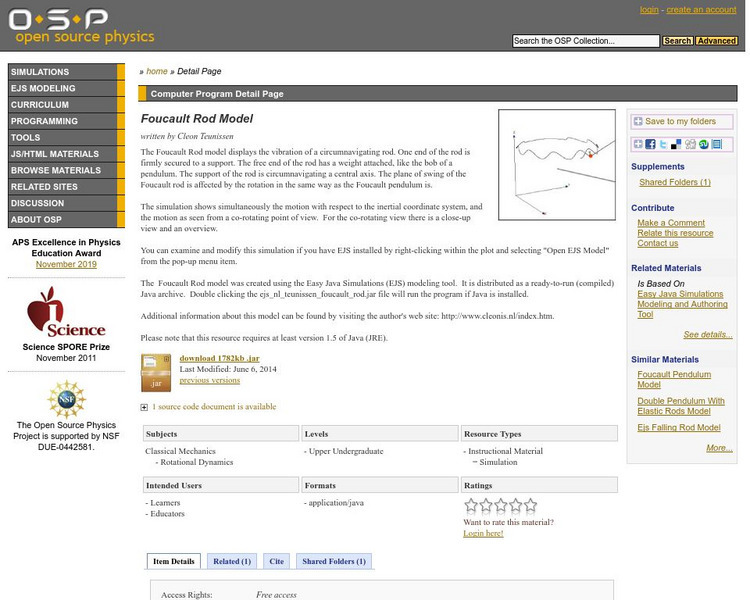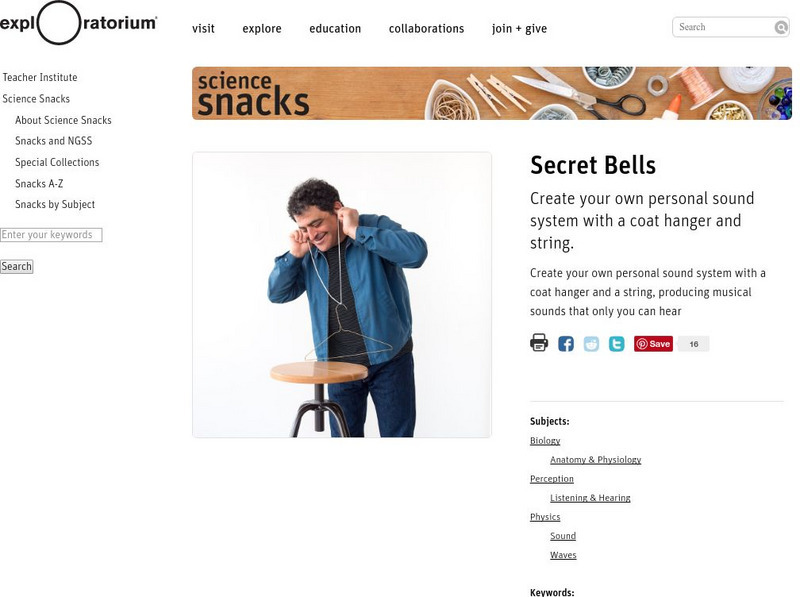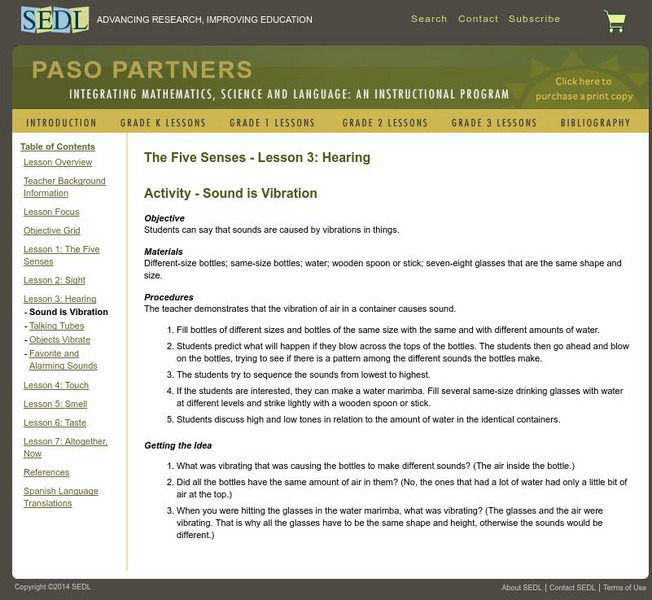University of Kentucky
The Physics and Math of Music
Read about a math research project done by three college students which helps us see physics and math in music. Here's a great approach for integrating curriculum!
PBS
Pbs: The Music Instinct: Good Vibrations! [Pdf]
Using the program "The Music Instinct," available on the PBS website, students will explore the nature of sound vibrations over two class periods.
Science Education Resource Center at Carleton College
Serc: Exploring Sound: Length Makes a Difference
Students begin to explore the relationship between the length of an object and the sound it produces as it vibrates, by using a wood or plastic ruler and the edge of a desk or table.
Project Britain
Primary Homework Help: Sound Quiz
Read some fast facts about sound energy first, then try a fourteen question review quiz. Check your answer after each question.
American Association of Physics Teachers
Com Padre Digital Library: Open Source Physics: Foucault Rod Model
A simulation illustrating the vibration of a circumnavigating rod. At least a 1.5 version of Java is required.
Open Curriculum
Open Curriculum: Vibrations
To understand the concept and properties of vibrations and periodic motions such as the Simple Harmonic motion.
Other
The University of Salford: Sounds Amazing
This site has several lessons all about sound. It introduces sound, then covers major principles of waves and the wave equation. Each lesson has interactive activities to keep you interested, and there are even some test questions.
Center of Science and Industry
Cosi Columbus: What's the Buzz?
Investigate what causes sound, and discover how to create different pitches. Includes full list of materials, procedures, and scientific explanation of vibration.
Museum of Science
Museum of Science and Industry: Online Science: Activities: Sound Like a Turkey
An activity where students investigate the sounds created by the friction of fingers moving along a wet string.
University Corporation for Atmospheric Research
Ucar: Atmospheric Processes Conduction
This simple demonstration helps students understand the concept of conduction. Site includes background information, images, and lesson plans outlining the demonstration of conduction.
Scholastic
Scholastic: Study Jams! Science: Energy, Light and Sound: Sound
A video and a short quiz on how sound travels in waves, its properties, and how to measure it.
Exploratorium
Exploratorium: Science Snacks: Secret Bells
An experiment demonstrating how sound vibrations transmit through metal.
Exploratorium
Exploratorium: Science Snacks: Vocal Visualizer
Create a vocalizer device out of PVC piping and, with the help of a laser pointer, use it to project a visualization of the sound vibrations you make with it.
Exploratorium
Exploratorium: Science Snacks: Bronx Cheer Bulb
In this activity observe how light sources flash as you give them a raspberry. As you complete the activity, make a conclusion about what is wiggling the lights or you.
Exploratorium
Exploratorium: Science Snacks: Coffee Can Cuica
In this activity students will use the engineering design process to make a musical instrument called a cuica. This musical instrument uses "stick-and-slip" vibrations to make the sound.
TeachEngineering
Teach Engineering: Seeing and Feeling Sound Vibrations
Students examine the existence of sound by listening to and seeing sound waves while conducting a set of simple activities as a class or in pairs at stations. Students describe sound in terms of its pitch, volume and frequency. They use...
TeachEngineering
Teach Engineering: Traveling Sound
Students explore how sound waves move through liquids, solids and gases in a series of simple sound energy experiments. Understanding the properties of sound and how sound waves travel helps engineers determine the best room shape and...
TeachEngineering
Teach Engineering: Pitch and Frequency
To further their understanding of sound energy, students identify the different pitches and frequencies created by a vibrating ruler and a straw kazoo. They create high- and low-pitch sound waves.
TeachEngineering
Teach Engineering: Energetic Musical Instruments
Students will learn to apply the principles and concepts associated with energy and the transfer of energy in an engineering context through the designing and making of a musical instrument. The students must choose from a variety of...
TeachEngineering
Teach Engineering: The Energy of Music
Students are introduced to sound energy concepts and how engineers use sound energy. Through hands-on activities and demonstrations, students examine how we know sound exists by listening to and seeing sound waves. They learn to describe...
Physics Classroom
The Physics Classroom: Forced Vibration
This physics tutorial explores forced vibration. Includes links to natural frequency, standing wave patterns and fundamental frequency and harmonics.
SEDL
Sw Educational Development Lab: Sound Is Vibrations
This lesson plan engages young students in the study of "sound." The questions What is vibration and what can affect it, thus affecting sound? will be answered during the lab.
Read Works
Read Works: Music in Your Ear
[Free Registration/Login Required] An informational text about guitars. A question sheet is available to help students build skills in reading comprehension.
Other
The Basics of Reading Music
This site is an overview of how to read music. The basics of notation such as note and rest values, the names of lines and spaces of both treble and bass clefs, etc. are covered. Includes downloadable audio files.



![Pbs: The Music Instinct: Good Vibrations! [Pdf] Lesson Plan Pbs: The Music Instinct: Good Vibrations! [Pdf] Lesson Plan](https://content.lessonplanet.com/knovation/original/32599-2e1d15a712acffd6c74d979ac6bcf592.jpg?1661522343)

















